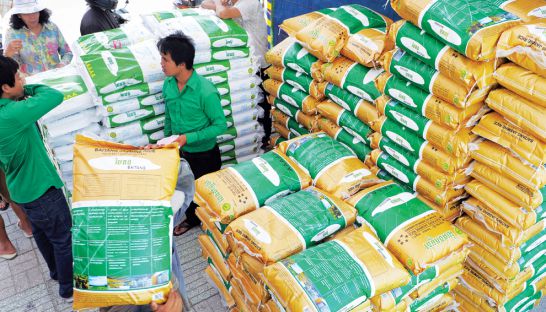Rice prices seen gaining ground in Mekong region
Rice prices seen gaining ground in Mekong region
A prolonged regional drought is expected to push Thai and Vietnamese rice prices up by 10 to 15 per cent, narrowing the price gap that has kept Cambodian rice exporters from securing major international supply orders, one of the Kingdom’s biggest rice exporters said yesterday.

Song Saran, CEO of Amru Rice, said while drought has afflicted all countries in the Lower Mekong region, the impact on Cambodia’s rice crop would be smaller than on that of its chief rivals.
“If Thailand’s price of white rice ends up increasing 10 to 15 per cent due to drought in early 2016, the price of Cambodia’s white rice will only increase by about 2 or 3 per cent because it is already more expensive than the product of its neighbours,” he said.
Prices for Thai 5 per cent broken white rice are currently quoted at $365 per tonne, lower than Vietnamese rice that is selling for $375-380 per tonne. By comparison, Cambodian 5 per cent broken rice is selling for about $420-430 per tonne, according to traders.
The honorary president of the Thai Rice Exporters Association projected this week that Thailand’s rice prices would increase by up to 15 per cent during the first quarter of 2016, and another 10 to 15 per cent in the second quarter if drought continues there, according to the Bangkok Post.
That could put the price difference between Thai and Cambodian rice to within a fraction, according to Saran.
Like its neighbours, Cambodia has felt the impact of a severe drought that scientists attribute to the El Niño weather phenomenon. However, Hean Vanhan, deputy director-general of the General Department of Agriculture at the Ministry of Agriculture, said late-season rains mitigated the impact of the dry spell.
“The drought did not have much impact on our rice yield due to the rainfall received at the end of the season, as well as water recovered [through irrigation,]” he said. “It’s now the harvest season, so it’s still too early to project the total paddy rice yield.”
Vanhan stressed that Cambodia would not face any food supply shortages as a result of this year’s drought. Some 9 million tonnes of paddy rice has been produced since the start of the year, of which 4 million tonnes was surplus.
Kim Savuth, vice president of the Cambodia Rice Federation, concurred.
“Even though the drought impacted the rice yield, it still did not impact the food supply or exports,” he said. “We have lots of surplus paddy rice in stock every year.”
However, Savuth disputed the notion that the price gap between Cambodian rice prices and those of its chief competitors would narrow, arguing that the much-larger scale of their rice exports drives world prices.
“Our rice price is dependent on Thailand and Vietnam’s market,” he said. “If their rice price increases, our rice price increases as well.”













